
RAF Sawbridgeworth History
Originally used as an Air Landing Ground during WWI.
Three Runways made from Sommerfeld tracking and linked by a concrete perimeter track were added during its later use in WWII.
In
1937
an
Advanced
Landing
Ground
(ALG)
was
established
to
the
North
of
the
Much
Hadham
road
near
Mathams
Wood.
This
consisted
of
a
43
acre
site
and
originally
named
as
Mathams
Wood
ALG.
This
was
on
the
site
of
a
night
landing
ground
dating
from
WWI
that
used
land
to
the
west
of
Shingle
Hall.
The
ALG
was
under
control
of
North
Weald
and
in
use
until
November
1918
when
it
reverted
to
agriculture
again.
Some
peacetime
flying
by a glider club saw some use of the 31 acre site during the late 1920's through to the middle of the next decade.
In
May
1940,
the
capitulation
of
France
saw
many
varied
squadrons
returning
home,
amongst
the
Fighter
and
Light
Bomber
units
were
Army
Co-
operation
Squadrons
equipped
with
the
high
wing
Westland
Lysander
aircraft.
These
had
been
used
for
Artillery
spotting
and
co-ordination,
and
needed
somewhere
to
go.
II(AC)
Squadron
was
one
such
unit.
When
the
Squadron
returned
from
France
in
1940,
it
landed
at
Hatfield
aerodrome
in
Hertfordshire,
but
deHavilland
were
not
happy
with
the
squadrons
aircraft
parked
there,
as
they
thought
it
would
attract
enemy
aircraft
to
the
valuable
aircraft
factory
on
the
site.
It
was
decided
to
take
the
aircraft
to
nearby
Mathams
Wood
ALG,
not
knowing
then
that
this
site
would
would
be
their
home on and off for the next four years.
W/C
Geddes
the
Commanding
Officer
of
the
squadron
was
responsible
for
making
the
changes
to
the
airfield
that
resulted
in
the
eventual
size
it
became.
Great
Hyde
Hall
(below
left)
was
requisitioned
first
as
the
HQ,
along
with
Blounts
Farm
nearby.
Up
to
late
1940
the
Air
Ministry
still
referred
the
site
as
Mathams
Wood
ALG,
but
W/C
Geddes
referred
to
it
in
a
telephone
conversation
one
day
to
the
Air
ministry
as
'RAF
Sawbridgeworth'.
The
Air
Ministry
were
told
that
the
ALG
was
being
upgraded
by
local
labour
to
suit
the
squadrons
needs
and
the
name
stuck.
Later,
the
squadron
traded
their
Lysanders
for
the
P-40
Curtiss
Tomahawk
for
a
while,
until
being
equipped
with
the
new
North
American
P-51
Mustang
(Below
right)
Called
the
Mustang 1 by the RAF.
A
"T2"
Hanger
was
erected
on
the
Shingle
Hall
site,
with
16
blister
hangers
situated
around
the
perimeter
track
of
40
feet
wide.
"Blenheim"
type
aircraft pens, of which the last remaining one appear's in the photo's, were located around the perimeter track.
The
flying
control
tower
was
situated
near
Shingle
Hall,
but
was
demolished
after
the
war
as
was
the
T2
Hangar.
Another
six
dispersed
site's
were
built for accomodation along Parsonage Lane.
The last Blenheim type dispersal pan in Mathams Wood
The
runways
were
Sommerfeld
tracking
with
a
Coir
matting
underlay
on
grass,
and
were
arranged
as
thus;
main
runway
orientated
at
130°/310°
at
1700 yards in length, secondary runway 060°/240° at 1400 yards in length and the third 010°/190° at a length of 900 yards.
Airfield
lighting
was
provided
of
the
'Drem'
type
,
normally
built
in
to
the
edge
of
the
concrete
runways
and
tracks,
these
were
set
in
concrete
blocks
off to the sides of the perimeter track and runways instead.
Many
varied
Squadrons
operated
out
of
Sawbridgeworth
during
it's
short
wartime
life,
notably
No
2
or
II(AC)
Squadron
operating
lysanders,Tomahawk
1's
then
Mustang
1's
were
the
principal
squadron
at
Sawbridgeworth,
This
Squadron
undertook
Ops
in
support
of
the
Army
for
photographic,
spotting,
and
Message
dropping
flights.
Other
Squadrons
at
Sawbridgworth
were
No
63,
168
and
170
Squadrons(Mustang
1's)
4
Squadron
(Mustangs),
then
later
in
1944
with
Spitfire
(PR),
4
Squadron(
B
flight
Mosquito
PR16)
80
Squadron
(Spitfire
9b)
182
Squadron
(Typhoon
1b)
268
Squadron
(Tomahawk1/2
Lysander,
Spitfire)
A
detachment
to
Sawbridgeworth
whilst
flying
Mustang
Mk.1
aircraft,
commencing
June
15,
1942,
concluding
about
August
9,
1942.
They
were
based
at
Sawbridgeworth
whilst
flying
Mustang
Mk.1A
aircraft
until
they
moved
to
Dundonald
for
Naval
Gunnery
Direction
training
and
then
onto
their
next
major
base,
Gatwick
on
April
8,
1942.
126
Squadron
(Spitfire
1Xe's).
SOE
1419
Flight,
later
to
become
138
(SD)
Squadron,
with
Lysanders
moving
to
Tempsford
.
This
flight
also
operated
Whitley
Bombers
converted
to
the
role
of
agent
dropping.
A
Lockheed
Hudson
aircraft
was
also
allocated
to
the
Squadron,
they
were
known
to
have
used
North
Weald,
Stapleford
Abbots in Essex, Stradishall & Newmarket in Suffolk as operating bases.
Special
Duties
and
Special
Operation's
Executive
were
involved
in
the
clandestine
operations
that
included
dropping
or
landing
trained
agents
in
occupied
Europe.
Landing
a
range
of
aircraft
in
remote
areas,
sometimes
right
under
the
Germans
noses.
They
also
undertook
supply
drops
of
arms,
ammunition,
and
explosives,
for
use
by
the
resistance
fighters.
One
of
the
most
well
known
airfields
for
these
types
of
operations
was
Tempsford
in
Bedfordshire,
and
its
resident
161(SD)
squadron.
138(SD)
were
also
based
there.
Lysander
aircraft
from
419,later
1419
flight
used
Sawbridgeworth
for
training,
in
fact
the
art
of
short
landing
by
a
simple
three
lamp
flarepath,
was
perfected
in
the
fields
around
Sawbridgeworth
airfield
by
II(AC)
squadrons
aircraft.
Several
'long
range
air
tests'
were
undertaken
by
Geddes
and
Scotter
of
II(AC)
With
Scotter
landing
at
Hornchurch
with
a
blackout
curtain
rigged
inside
the
rear
part
of
the
cockpit,
hiding
the
passenger.
This
suggests
clandestine
flights
by
'black'
Lysanders
may
well
have
taken
place,
and
originated
at
Sawbridgeworth
itself.
Due
to
the
secretive
nature
of
SOE
and
it's
operations,
this
has
never
been,
or
can
be
confirmed
by
documentation.
The
airfield
defences
are
still
evident,
for
instance,on
the
Much
Hadham
road
is
a
type
24
Pillbox
with
the
remains
of
the
road
barrier
placed
next
to
it.
This
point
marked
the
boundary
of
the
airfield.
The
Much
Hadham
road
that
runs
through
the
remains
of
the
airfield,
would
have
been
shut
at
his
point
during the War. Traffic was probably diverted down and around Allens Green to get around the airfield.
The
runways
were
Sommerfeld
tracking
on
grass.
There
are
references
to
an
Air
Ministry
experiment
using
Coir
underlay.
This
was
made
from
coconut
husks
woven
into
a
matting,
and
laid
across
the
grass
runways.
But
apparently
it
was
a
disaster
at
Sawbridgeworth
due
to
the
high
water
table.
For
the
matting
soaked
into
the
grass
and
turned
into
a
marsh
for
several
weeks
in
the
winter
time.
This
prohibited
the
heavier
aircraft
from
using the field, "B" flight of 4 Squadron operating their Mosquito aircraft, were forced to operate their aircraft from Hunsdon for a time.
A poem written in 35 Wing's newsheet at the time records this ditty regarding the wetness of the airfield;
'Move on you jolly campers! farewell to Sawbridgeworth!
Where everything is clampers,the dullest place on Earth.
Move out from winter quarters! if they exist as such,
the joy of Bishops Storters, We haven't Hadham much'.
The
airfield
was
starting
to
be
used
less
by
the
middle
of
1944
due
to
the
Invasion
of
the
Continent,
and
flying
ceased
on
the
10th
of
November
1944.
The
airfield
closed
officially
in
March
1947,
the
last
remaining
RAF
non
flying
personnel
had
gone
for
good.
Not
a
great
deal
remains
of
Sawbridgeworth
airfield
today,
but
it
has
faired
better
than
nearby
Hunsdon
in
regard
to
many
original
buildings
remaining
on
the
technical
site.
This
is
due to the care and maintenance of those buildings by the Landowner Mr David Morris.
Of
the
airfield
itself,
Most
of
the
perimeter
track
remains.
With
only
a
short
section
missing
from
behind
Blounts
Farm.
There
are
two
aircraft
dispersal
pens
of
the
"Blenheim"type,
complete
with
blast
walls
and
air
raid
shelter
remaining.
There
are
several
of
the
wartime
buildings
at
Shingle
hall
and
Woodside
trading
estate
that
are
being
used
as
light
industrial
units,
all
are
in
good
order.
Several
shelters
and
pillboxes
remain,
along
with
an
early
Spigot mortar position.The Battle Headquarters building is extant but flooded.
RAF Sawbridgeworth-The Human element.
One
pilot
who
flew
with
II(AC)
during
WWII
from
Sawbridgeworth
is
Doug
Reich,
Doug,
who
now
lives
in
North Wales was with 'B' flight and recalls the trials and tribulations of operating from Sawbridgworth.
I
joined
2
Squadron
at
the
end
of
May
1943
and
served
with
the
squadron
until
crashing
in
the
River
Seine
near
Rouen,
France
on
the
15th
June
1944.
We
were
flying
from
Gatwick
when
the
crash
happened
and
due
to
hitting
the
water
while
strafing
a
german
ferry
boat.
I
lost
contact
with
many
of
my
friends
as
I
spent
the
rest
of
the
war
in
Stalag
Luft
1
on
the
Baltic
coast.
The
mustang
1
had
two
.50
calibre
heavy
machine
guns,
The
main
role
of
the
aircraft
being
Tac/Eval
photo
recconaisance.
These
guns
were
extremely
difficult
to
cock
once
in
the
cockpit.
sometimes
I
had
to
let
go
of
the
stick,
and
put
both
feet
on
the
instrument
panel
to
pull
the cocking levers back'
The
photo
below
is
of
me
flying
over
Flt/Lt
George
Kenning
who
was
on
the
ground,
changing
aircraft,
after
shooting
holes
in
his
own
propellor.
This
happened
after
he
has
cocked
the
guns
on
the
ground,
While
taxying
he
hit
a
pothole
in
the
perimeter
track
and
shot
holes
in
his
propellor.
The
guns
were
not
synchronised
at
such
low
revs.
after
he
got
airborne
again,
we
set
course
for
a
shipping
recce
off
of
the
Friesian Islands.
Doug pictured flying over George Kenning while waiting for him to change aircraft.
Pilots of 'B flight' II(AC) Squadron at Sawbridgeworth 1943
From left to right F/Lt George Kenning; F/Lt Wakefield; F/O Andrews;
F/O Doug Reich; F/O Redman; F/O Stephen Shayle-George.
Above- Doug flying back from a sortie over enemy occupied France, photo taken by his wingman.
II(AC) had other aircraft for use as communications transports, including a Boulton-Paul Defiant and a Fairey Battle.
'On
a
later
occasion
when
returning
from
an
op,
I
decided
to
do
a
front
wheel
landing
in
which
you
actually
fly
the
A/C
onto
the
runway
at
120
mph,
then
cut
the
throttle.
I
had
cocked
my
guns
but
not
fired
them,
and
when
the
wheels
touched
the
runway,
the
guns
fired
through
the
arc
of
the
prop.
As
there was no report of anyone being shot, I breathed a sigh of relief, and from then on stuck to three-point landings!'
Shortly
after
the
squadron
moved
to
Gatwick,
Doug
and
his
wingman
were
sent
on
a
armed
TAC/Eval
to
the
area
inland
of
the
Seine
estuary,
while
strafing
a
german
ferry,
Dougs
Mustang
clipped
the
water
and
the
aircraft
cartwheeled
in.
Doug
being
unconscious,
floated
free
when
the
aircraft
broke
up.
He
floated
in
the
water
for
6
hours
before
a
French
fisherman
pulled
him
out
and
took
him
to
the
Germans
for
medical
assistance.
After
he
spent time in a German controlled hospital, he was incarcerated in Sagen POW camp.
Three members of II(AC) Squadron- Doug Reich (left) Wing Commander Andrew Hine (centre) and Ivor Harris (Right)
Pictured at the Sawbridgeworth airfield Memorial dedication day 2006
W/C Andrew Hine was the current commanding officer of II(AC) Squadron at Marham
Ivor Harris was shot down a few days after Doug, and ended up in the same Prisoner of War camp as Doug.
Ivor Harris sadly passed away in 2011
Flt/Lt Stephen John Shayle-George 1943.
Shortly
after
the
declaration
of
war
against
Germany,
Prime
Minister
Michael
Joseph
Savage
announced
New
Zealand’s
war
aims
in
a
radio
broadcast
on
5
September
1939.
Towards
the
end
of
that
address,
he
declared
that:
"Both
with
gratitude
for
the
past
and
with
confidence
in
the
future
we
range
ourselves
without
fear
beside
Britain.
Where
she
goes,
we
go,
where
she
stands,
we
stand."In
New
Zealand
a
Ballot
system
was
introduced
based
on
birthdates,
where
all
eligible
young
men
were
called
up.
December
1940
Stephen’s
name
came
up
and
immediately
enlisted
himself
into
the
Air
Force
and
started
instruction
courses
around
New
Zealand.
September
1941
Stephen
left
New
Zealand,
by
sea
on
the
MV
Monowai,
for
Canada
and
further
training.
Got
his
commission
on
7
December
1941,
on
the
day
the
Japanese
bombed
Pearl
Harbour.With
German
"U-Boats"
patrolling
the
Atlantic
seas
between
USA/Canada
and
the
UK
getting
from
Canada
now
proved
more
perilous.
Avoiding
the
big
escorted
convoys
and
anxious
to
join
the
war
effort,
Stephen
volunteered
to
go
to
England
on
a
Norwegian
3,000
ton
freighter
carrying
a
cargo
of
Bacon
with
about
12
others
and
arrived
in
Liverpool
on
February
1942
and
given
2-weeks
R&R.
He
spent
this
time
wisely
on
a
farm
around
Gloucestershire,
(his
New
Zealand
upbringing
showing
here!).
This
method
of
transport
was
the
‘way’
to
avoid
the
German
U-Boats!
It
was
rumoured
that
on
the
next
sailing
this
Freighter
was
sunk
with
the
loss
of
all
on
board.After
1-week
on
the
farm
he
was
called
into
service
being
sent
to
RAF
Old
Sarum,
where
Stephen
was
introduced
to
the
Lysander,
and
not
the
Spitfire
that
he
had
hoped
for!.
After
the
initial
disappointment
at
not
being
assigned
to
a
Spitfire
Squadron
Stephen
became
adept
at
handling
the
Lysander
in
all
aspects
of
its
idiosyncrasies!Particular
memories
were
of
the
long
periods
they
spent
training
on
‘instrument
flying’
where
the
instructor
sat
in
the
front
and
the
rear
compartment
was
blacked
out
to
simulate
the
conditions.
The
Lysander
was
coming
to
the
end
of
its
time
and
Stephen
moved
onto
the
Curtiss
P-40
Tomahawk.
These
US
manufactured
aircraft
had
been
manufactured
for
the
French
Air
Force
and
were
in
metric
configuration
which
posed
a
few
problems
of
their
own.
Unfortunately
Stephen
caught
a
severe
bought
of
Pneumonia
which
saw
him
admitted
to
the
Air
Force
Special
Hospital
at
Wroughton.
After
a
long
time
he
was
advised
not
to
go
to
the
convalescence
centre
at
Torquay
but
spend
time
on
a
farm.
He
only
knew
one
farm,
in
Gloucestershire.
The
approach
was
made
and
accepted
and
so
a
wonderful
relationship
developed,
staying
for
a
month,
to
return
to
the
Squadron
where
they
all
thought
they
would
never
see
him
again.
This
being
around
May/June
1942.
(Just
a
note
here;
It
was
the
Farmers
niece
that
Stephen
was
later
to
marry,
and
bring
back
to
New
Zealand
to
settle
down
with.)Soon
after
the
Tomahawk,
the
P-51
Mustang
arrived
and
it
was
in
the
middle
of
1943
that
Stephen
was
assigned
to
No:
2
Squadron,
Army
Co-
operation Command, at Sawbridgeworth flying the P-51.
These
beautiful
high
speed
aircraft,
well
suited
for
Army
support,
with
their
aerodynamic
lines,
were
cut
about
to
mount
cameras
to
cover
every
angle.
Even
accommodating
the
Pilots
parachute
had
to
be
modified
so
as
to
ensure
the
operation
of
another
camera!
Such
were
the
trials
of
the
Army
co-
operation
pilots
at
that
time.Stephen
left
Sawbridgeworth
at
the
end
of
1943
after
approx
6-months
there,
and
went
to
Gravesend
where
he
was
involved in instruction work with pilots from Canada prior to them joining the RAF.
Stephen Shayle-George still resides in New Zealand. One of that Countries sons who made the long journey to Great Britain to do his duty.
Sadly, Stephen John Shayle-George passed away in January 2009.
©All images and text copyright of wartime-airfields.com unless stated otherwise. Please do not copy to wikipedia!



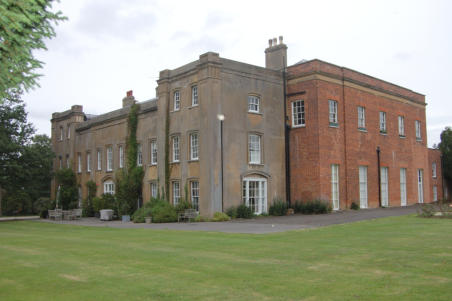

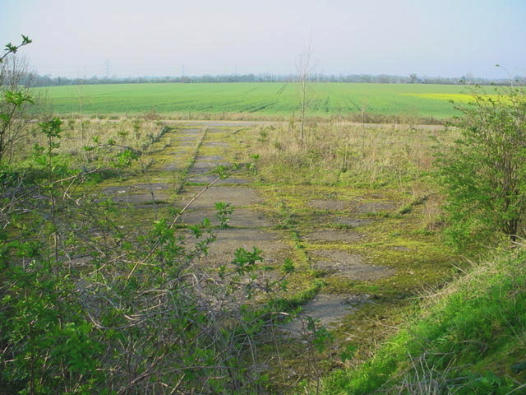











Wartime Airfields
rjkdesign
Wartime Airfields
rjkdesign


Wartime Airfields
Wartime Airfields

RAF Sawbridgeworth History

Originally used as an Air Landing Ground during WWI.
Three Runways made from Sommerfeld tracking and linked by a
concrete perimeter track were added during its later use in WWII.
In
1937
an
Advanced
Landing
Ground
(ALG)
was
established
to
the
North
of
the
Much
Hadham
road
near
Mathams
Wood.
This
consisted
of
a
43
acre
site
and
originally
named
as
Mathams
Wood
ALG.
This
was
on
the
site
of
a
night
landing
ground
dating
from
WWI
that
used
land
to
the
west
of
Shingle
Hall.
The
ALG
was
under
control
of
North
Weald
and
in
use
until
November
1918
when
it
reverted
to
agriculture
again.
Some
peacetime
flying
by
a
glider
club
saw
some
use
of
the
31
acre
site
during
the
late
1920's
through
to
the
middle
of
the
next
decade.
In
May
1940,
the
capitulation
of
France
saw
many
varied
squadrons
returning
home,
amongst
the
Fighter
and
Light
Bomber
units
were
Army
Co-operation
Squadrons
equipped
with
the
high
wing
Westland
Lysander
aircraft.
These
had
been
used
for
Artillery
spotting
and
co-
ordination,
and
needed
somewhere
to
go.
II(AC)
Squadron
was
one
such
unit.
When
the
Squadron
returned
from
France
in
1940,
it
landed
at
Hatfield
aerodrome
in
Hertfordshire,
but
deHavilland
were
not
happy
with
the
squadrons
aircraft
parked
there,
as
they
thought
it
would
attract
enemy
aircraft
to
the
valuable
aircraft
factory
on
the
site.
It
was
decided
to
take
the
aircraft
to
nearby
Mathams
Wood
ALG,
not
knowing
then
that
this
site
would
would
be
their
home
on
and
off
for
the
next
four
years.
W/C
Geddes
the
Commanding
Officer
of
the
squadron
was
responsible
for
making
the
changes
to
the
airfield
that
resulted
in
the
eventual
size
it
became.
Great
Hyde
Hall
(below
left)
was
requisitioned
first
as
the
HQ,
along
with
Blounts
Farm
nearby.
Up
to
late
1940
the
Air
Ministry
still
referred
the
site
as
Mathams
Wood
ALG,
but
W/C
Geddes
referred
to
it
in
a
telephone
conversation
one
day
to
the
Air
ministry
as
'RAF
Sawbridgeworth'.
The
Air
Ministry
were
told
that
the
ALG
was
being
upgraded
by
local
labour
to
suit
the
squadrons
needs
and
the
name
stuck.
Later,
the
squadron
traded
their
Lysanders
for
the
P-40
Curtiss
Tomahawk
for
a
while,
until
being
equipped
with
the
new
North
American P-51 Mustang (Below right) Called the Mustang 1 by the RAF.
A
"T2"
Hanger
was
erected
on
the
Shingle
Hall
site,
with
16
blister
hangers
situated
around
the
perimeter
track
of
40
feet
wide.
"Blenheim"
type
aircraft
pens,
of
which
the
last
remaining
one
appear's
in
the
photo's, were located around the perimeter track.
The
flying
control
tower
was
situated
near
Shingle
Hall,
but
was
demolished
after
the
war
as
was
the
T2
Hangar.
Another
six
dispersed
site's were built for accomodation along Parsonage Lane.
The last Blenheim type dispersal pan in Mathams Wood
The
runways
were
Sommerfeld
tracking
with
a
Coir
matting
underlay
on
grass,
and
were
arranged
as
thus;
main
runway
orientated
at
130°/310°
at
1700
yards
in
length,
secondary
runway
060°/240°
at
1400
yards in length and the third 010°/190° at a length of 900 yards.
Airfield
lighting
was
provided
of
the
'Drem'
type
,
normally
built
in
to
the
edge
of
the
concrete
runways
and
tracks,
these
were
set
in
concrete
blocks off to the sides of the perimeter track and runways instead.
Many
varied
Squadrons
operated
out
of
Sawbridgeworth
during
it's
short
wartime
life,
notably
No
2
or
II(AC)
Squadron
operating
lysanders,Tomahawk
1's
then
Mustang
1's
were
the
principal
squadron
at
Sawbridgeworth,
This
Squadron
undertook
Ops
in
support
of
the
Army
for
photographic,
spotting,
and
Message
dropping
flights.
Other
Squadrons
at
Sawbridgworth
were
No
63,
168
and
170
Squadrons(Mustang
1's)
4
Squadron
(Mustangs),
then
later
in
1944
with
Spitfire
(PR),
4
Squadron(
B
flight
Mosquito
PR16)
80
Squadron
(Spitfire
9b)
182
Squadron
(Typhoon
1b)
268
Squadron
(Tomahawk1/2
Lysander,
Spitfire)
A
detachment
to
Sawbridgeworth
whilst
flying
Mustang
Mk.1
aircraft,
commencing
June
15,
1942,
concluding
about
August
9,
1942.
They
were
based
at
Sawbridgeworth
whilst
flying
Mustang
Mk.1A
aircraft
until
they
moved
to
Dundonald
for
Naval
Gunnery
Direction
training
and
then
onto
their
next
major
base,
Gatwick
on
April
8,
1942.
126
Squadron
(Spitfire
1Xe's).
SOE
1419
Flight,
later
to
become
138
(SD)
Squadron,
with
Lysanders
moving
to
Tempsford
.
This
flight
also
operated
Whitley
Bombers
converted
to
the
role
of
agent
dropping.
A
Lockheed
Hudson
aircraft
was
also
allocated
to
the
Squadron,
they
were
known
to
have
used
North
Weald,
Stapleford
Abbots
in
Essex,
Stradishall
&
Newmarket
in
Suffolk
as
operating
bases.
Special
Duties
and
Special
Operation's
Executive
were
involved
in
the
clandestine
operations
that
included
dropping
or
landing
trained
agents
in
occupied
Europe.
Landing
a
range
of
aircraft
in
remote
areas,
sometimes
right
under
the
Germans
noses.
They
also
undertook
supply
drops
of
arms,
ammunition,
and
explosives,
for
use
by
the
resistance
fighters.
One
of
the
most
well
known
airfields
for
these
types
of
operations
was
Tempsford
in
Bedfordshire,
and
its
resident
161(SD)
squadron.
138(SD)
were
also
based
there.
Lysander
aircraft
from
419,later
1419
flight
used
Sawbridgeworth
for
training,
in
fact
the
art
of
short
landing
by
a
simple
three
lamp
flarepath,
was
perfected
in
the
fields
around
Sawbridgeworth
airfield
by
II(AC)
squadrons
aircraft.
Several
'long
range
air
tests'
were
undertaken
by
Geddes
and
Scotter
of
II(AC)
With
Scotter
landing
at
Hornchurch
with
a
blackout
curtain
rigged
inside
the
rear
part
of
the
cockpit,
hiding
the
passenger.
This
suggests
clandestine
flights
by
'black'
Lysanders
may
well
have
taken
place,
and
originated
at
Sawbridgeworth
itself.
Due
to
the
secretive
nature
of
SOE
and
it's
operations,
this
has
never
been,
or
can
be
confirmed by documentation.
The
airfield
defences
are
still
evident,
for
instance,on
the
Much
Hadham
road
is
a
type
24
Pillbox
with
the
remains
of
the
road
barrier
placed
next
to
it.
This
point
marked
the
boundary
of
the
airfield.
The
Much
Hadham
road
that
runs
through
the
remains
of
the
airfield,
would
have
been
shut
at
his
point
during
the
War.
Traffic
was
probably
diverted
down
and
around Allens Green to get around the airfield.
The
runways
were
Sommerfeld
tracking
on
grass.
There
are
references
to
an
Air
Ministry
experiment
using
Coir
underlay.
This
was
made
from
coconut
husks
woven
into
a
matting,
and
laid
across
the
grass
runways.
But
apparently
it
was
a
disaster
at
Sawbridgeworth
due
to
the
high
water
table.
For
the
matting
soaked
into
the
grass
and
turned
into
a
marsh
for
several
weeks
in
the
winter
time.
This
prohibited
the
heavier
aircraft
from
using
the
field,
"B"
flight
of
4
Squadron
operating
their
Mosquito
aircraft,
were
forced
to
operate
their
aircraft
from
Hunsdon
for
a time.
A poem written in 35 Wing's newsheet at the time records this ditty
regarding the wetness of the airfield.
'Move on you jolly campers! farewell to Sawbridgeworth!
Where everything is clampers,the dullest place on Earth.
Move out from winter quarters! if they exist as such,
the joy of Bishops Storters, We haven't Hadham much'.
The
airfield
was
starting
to
be
used
less
by
the
middle
of
1944
due
to
the
Invasion
of
the
Continent,
and
flying
ceased
on
the
10th
of
November
1944.
The
airfield
closed
officially
in
March
1947,
the
last
remaining
RAF
non
flying
personnel
had
gone
for
good.
Not
a
great
deal
remains
of
Sawbridgeworth
airfield
today,
but
it
has
faired
better
than
nearby
Hunsdon
in
regard
to
many
original
buildings
remaining
on
the
technical
site.
This
is
due
to
the
care
and
maintenance
of
those
buildings by the Landowner Mr David Morris.
Of
the
airfield
itself,
Most
of
the
perimeter
track
remains.
With
only
a
short
section
missing
from
behind
Blounts
Farm.
There
are
two
aircraft
dispersal
pens
of
the
"Blenheim"type,
complete
with
blast
walls
and
air
raid
shelter
remaining.
There
are
several
of
the
wartime
buildings
at
Shingle
hall
and
Woodside
trading
estate
that
are
being
used
as
light
industrial
units,
all
are
in
good
order.
Several
shelters
and
pillboxes
remain,
along
with
an
early
Spigot
mortar
position.The
Battle
Headquarters building is extant but flooded.
RAF Sawbridgeworth-The Human element.
One
pilot
who
flew
with
II(AC)
during
WWII
from
Sawbridgeworth
is
Doug
Reich,
Doug,
who
now
lives
in
North
Wales
was
with
'B'
flight
and
recalls
the
trials
and
tribulations
of operating from Sawbridgworth.
I
joined
2
Squadron
at
the
end
of
May
1943
and
served
with
the
squadron
until
crashing
in
the
River
Seine
near
Rouen,
France
on
the
15th
June
1944.
We
were
flying
from
Gatwick
when
the
crash
happened
and
due
to
hitting
the
water
while
strafing
a
german
ferry
boat.
I
lost
contact
with
many
of
my
friends
as
I
spent
the
rest
of
the
war
in
Stalag
Luft
1
on
the
Baltic
coast.
The
mustang
1
had
two
.50
calibre
heavy
machine
guns,
The
main
role
of
the
aircraft
being
Tac/Eval
photo
recconaisance.
These
guns
were
extremely
difficult
to
cock
once
in
the
cockpit.
sometimes
I
had
to
let
go
of
the
stick,
and
put
both feet on the instrument panel to pull the cocking levers back'
The
photo
below
is
of
me
flying
over
Flt/Lt
George
Kenning
who
was
on
the
ground,
changing
aircraft,
after
shooting
holes
in
his
own
propellor.
This
happened
after
he
has
cocked
the
guns
on
the
ground,
While
taxying
he
hit
a
pothole
in
the
perimeter
track
and
shot
holes
in
his
propellor.
The
guns
were
not
synchronised
at
such
low
revs.
after
he
got
airborne
again,
we
set
course
for
a
shipping
recce
off
of
the
Friesian
Islands.
Doug pictured flying over George Kenning while waiting for him to
change aircraft.
Pilots of 'B flight' II(AC) Squadron at Sawbridgeworth 1943
From left to right F/Lt George Kenning; F/Lt Wakefield; F/O Andrews;
F/O Doug Reich; F/O Redman; F/O Stephen Shayle-George.
Above - Doug flying back from a sortie over enemy occupied France,
photo taken by his wingman.
II(AC) had other aircraft for use as communications transports,
including a Boulton-Paul Defiant and a Fairey Battle.
'On
a
later
occasion
when
returning
from
an
op,
I
decided
to
do
a
front
wheel
landing
in
which
you
actually
fly
the
A/C
onto
the
runway
at
120
mph,
then
cut
the
throttle.
I
had
cocked
my
guns
but
not
fired
them,
and
when
the
wheels
touched
the
runway,
the
guns
fired
through
the
arc
of
the prop. As there was no report of anyone being shot, I breathed a sigh
of relief, and from then on stuck to three-point landings!'
Shortly
after
the
squadron
moved
to
Gatwick,
Doug
and
his
wingman
were
sent
on
a
armed
TAC/Eval
to
the
area
inland
of
the
Seine
estuary,
while
strafing
a
german
ferry,
Dougs
Mustang
clipped
the
water
and
the
aircraft
cartwheeled
in.
Doug
being
unconscious,
floated
free
when
the
aircraft
broke
up.
He
floated
in
the
water
for
6
hours
before
a
French
fisherman
pulled
him
out
and
took
him
to
the
Germans
for
medical
assistance.
After
he
spent
time
in
a
German
controlled
hospital,
he
was
incarcerated in Sagen POW camp.
Three members of II(AC) Squadron- Doug Reich (left) Wing
Commander Andrew Hine (centre) and Ivor Harris (Right)
Pictured at the Sawbridgeworth airfield Memorial dedication day 2006
W/C Andrew Hine was the current commanding officer of II(AC)
Squadron at Marham
Ivor Harris was shot down a few days after Doug, and ended up in the
same Prisoner of War camp as Doug.
Ivor Harris sadly passed away in 2011.
Flt/Lt Stephen John Shayle-George 1943.
Shortly
after
the
declaration
of
war
against
Germany,
Prime
Minister
Michael
Joseph
Savage
announced
New
Zealand’s
war
aims
in
a
radio
broadcast
on
5
September
1939.
Towards
the
end
of
that
address,
he
declared
that:
"Both
with
gratitude
for
the
past
and
with
confidence
in
the future we range ourselves without fear beside Britain.
Where
she
goes,
we
go,
where
she
stands,
we
stand."In
New
Zealand
a
Ballot
system
was
introduced
based
on
birthdates,
where
all
eligible
young
men
were
called
up.
December
1940
Stephen’s
name
came
up
and
immediately
enlisted
himself
into
the
Air
Force
and
started
instruction
courses
around
New
Zealand.
September
1941
Stephen
left
New
Zealand,
by
sea
on
the
MV
Monowai,
for
Canada
and
further
training.
Got
his
commission
on
7
December
1941,
on
the
day
the
Japanese
bombed
Pearl
Harbour.With
German
"U-Boats"
patrolling
the
Atlantic
seas
between
USA/Canada
and
the
UK
getting
from
Canada
now proved more perilous.
Avoiding
the
big
escorted
convoys
and
anxious
to
join
the
war
effort,
Stephen
volunteered
to
go
to
England
on
a
Norwegian
3,000
ton
freighter
carrying
a
cargo
of
Bacon
with
about
12
others
and
arrived
in
Liverpool
on
February
1942
and
given
2-weeks
R&R.
He
spent
this
time
wisely
on
a
farm
around
Gloucestershire,
(his
New
Zealand
upbringing
showing
here!).
This
method
of
transport
was
the
‘way’
to
avoid
the
German
U-Boats!
It
was
rumoured
that
on
the
next
sailing
this
Freighter
was sunk with the loss of all on board.
After
1-week
on
the
farm
he
was
called
into
service
being
sent
to
RAF
Old
Sarum,
where
Stephen
was
introduced
to
the
Lysander,
and
not
the
Spitfire
that
he
had
hoped
for!.
After
the
initial
disappointment
at
not
being
assigned
to
a
Spitfire
Squadron
Stephen
became
adept
at
handling
the
Lysander
in
all
aspects
of
its
idiosyncrasies!Particular
memories
were
of
the
long
periods
they
spent
training
on
‘instrument
flying’
where
the
instructor
sat
in
the
front
and
the
rear
compartment
was blacked out to simulate the conditions.
The
Lysander
was
coming
to
the
end
of
its
time
and
Stephen
moved
onto
the
Curtiss
P-40
Tomahawk.
These
US
manufactured
aircraft
had
been
manufactured
for
the
French
Air
Force
and
were
in
metric
configuration
which
posed
a
few
problems
of
their
own.
Unfortunately
Stephen
caught
a
severe
bought
of
Pneumonia
which
saw
him
admitted
to
the
Air
Force
Special
Hospital
at
Wroughton.
After
a
long
time
he
was
advised
not
to
go
to
the
convalescence
centre
at
Torquay
but
spend
time
on
a
farm.
He
only
knew
one
farm,
in
Gloucestershire.
The
approach
was
made
and
accepted
and
so
a
wonderful
relationship
developed,
staying
for
a
month,
to
return
to
the
Squadron
where
they
all
thought they would never see him again.
This
being
around
May/June
1942.
(Just
a
note
here;
It
was
the
Farmers
niece
that
Stephen
was
later
to
marry,
and
bring
back
to
New
Zealand
to
settle
down
with.)Soon
after
the
Tomahawk,
the
P-51
Mustang
arrived
and
it
was
in
the
middle
of
1943
that
Stephen
was
assigned
to
No:
2
Squadron,
Army
Co-operation
Command,
at
Sawbridgeworth flying the P-51.
These
beautiful
high
speed
aircraft,
well
suited
for
Army
support,
with
their
aerodynamic
lines,
were
cut
about
to
mount
cameras
to
cover
every
angle.
Even
accommodating
the
Pilots
parachute
had
to
be
modified
so
as
to
ensure
the
operation
of
another
camera!
Such
were
the
trials
of
the
Army
co-operation
pilots
at
that
time.Stephen
left
Sawbridgeworth
at
the
end
of
1943
after
approx
6-months
there,
and
went
to
Gravesend
where
he
was
involved
in
instruction
work
with
pilots
from Canada prior to them joining the RAF.
Stephen
Shayle-George
still
resides
in
New
Zealand.
One
of
that
Countries
sons
who
made
the
long
journey
to
Great
Britain
to
do
his
duty.
Sadly, Stephen John Shayle-George passed away in January 2009.
©All images and text copyright of wartime-airfields.com unless stated
otherwise. Please do not copy to wikipedia!

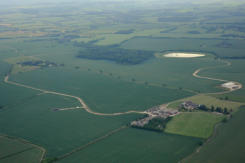


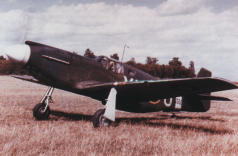




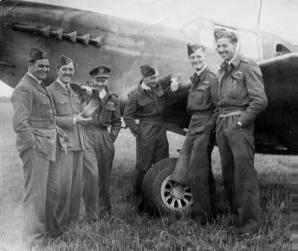
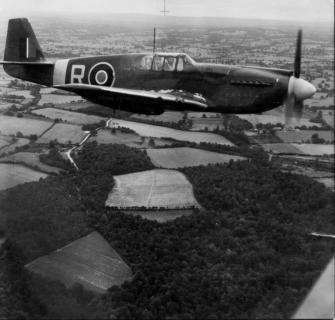






rjkdesign













